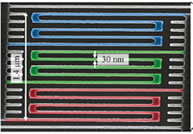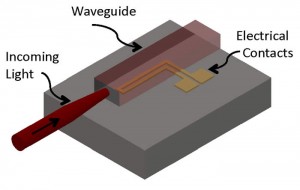We design and fabricate superconducting nanowire single photon detectors (SNSPDs). SNSPDs are appropriate for many applications because they have low jitter, a fast reset time and good sensitivity to infrared light. Thus, we are working on several research projects to improve device performance. For example, we are trying to increase the active area and the detection efficiency, and we are pushing the limits of electron-beam lithography to pattern more sensitive detectors reliably. We are also interested in understanding their operation, including their thermal behavior and the origin of jitter. With better understanding, we’ll be able to design higher performance detectors for quantum communication and other applications.
Superconducting Nanowire Avalanche Photon detectors (SNAPs)
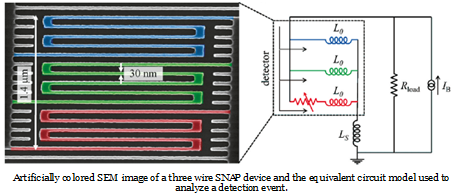
Superconducting Nanowire Avalanche Photon detectors (SNAPs) combine multiple Superconducting Nanowire Single Photon Detectors (SNSPDs) into one device. By arranging two to four SNSPDs in parallel, a device can be created that is more sensitive to incoming photons. The increased sensitivity of a SNAP device allows narrowing the wire width and thereby enabling the detection of higher wavelength photons. We have demonstrated saturated detection efficiency into the mid-IR range.
“Single-Photon Detectors Based on Ultranarrow Superconducting Nanowires,” Francesco Marsili, Faraz Najafi, Eric Dauler, Francesco Bellei, Xiaolung Hu, Maria Csete, Richard J. Molnar, and Karl K. Berggren, Nano Letters 11(5) 2048 (2011).
Integration of optical systems with SNSPDs
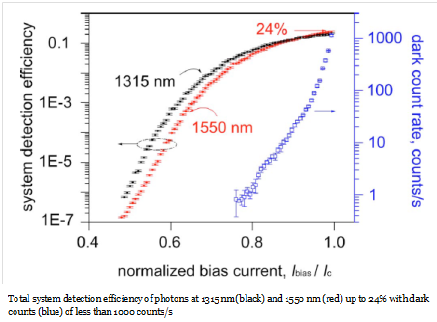
We developed a fiber-coupled superconducting nanowire single-photon detector system in a close-cycle cryocooler and achieved 24% and 22% system detection efficiencies at wavelengths of 1550 and 1315 nm, respectively. The maximum dark count rate was ~ 1000 counts/s. The system included a 9mm circular detector with an integrated microcavity to enhance the optical absorption. Nanopositioners were used to achieve ~ 80 % coupling efficiency between the optical fiber and the detector.
“Fiber-coupled nanowire photon counter at 1550 nm with 24% system detection efficiency,” Xiaolong Hu, Tian Zhong, James E. White, Eric A. Dauler, Faraz Najafi, Charles H. Herder, Franco N. C. Wong, and Karl K. Berggren, Optics Letters 34, pp. 3607-3609 (2009)
Quantum Optics
In addition to integrating optical cavities to superconducting nanowire single-photon detectors (SNSPDs), we proposed a design for SNSPDs integrated with a silicon nitride waveguide and an inverse-taper coupler for fiber coupling. According to finite-element simulations, the absorptance of the NBN nanowire can reach 76% at a wavelength of 1550 nm [1].
We also recently demonstrated detection of 1.3-µm polarization-entangled photons over 200-m fiber-optic cables. The high efficiency and low dark counts of the SNSPD allowed a coincidence rate per unit power that was improved by a factor of 150 over previous measurements using gated InGaAs detectors [2].
- “Efficiently Coupling Light to Superconducting Nanowire Single-Photon Detectors,” Xiaolong Hu, Charles W. Holzwarth, Daniele Masciarelli, Eric A. Dauler, and Karl K. Berggren, IEEE Transactions on Applied Superconductivity 19, pp. 336-340 (2009).
- “High-quality fiber-optic polarization entanglement distribution at 1.3µm telecom wavelength,” Tian Zhong, Xiaolong Hu, Franco N. C. Wong, Karl K. Berggren, Tony D. Roberts, and Philip Battle, Optics Letters 35, pp. 1392-1394 (2010).
Transmission Line Integrated Superconducting Ion Traps
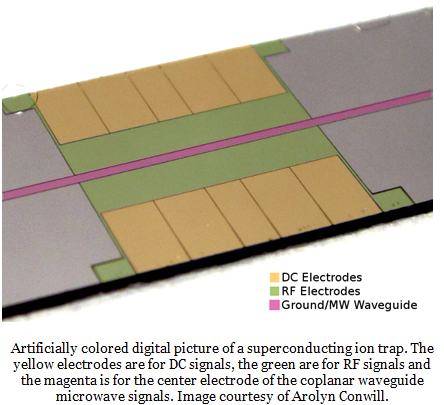
In collaboration with Isaac Chuang we have developed superconducting surface electrode ion traps with integrated transmission lines. We initially plan to use these transmission line integrated ion traps to perform microwave spectroscopy on trapped polar molecular ions. We have also used superconducting microwave cavities in place of the transmission lines and shown that superconducting resonators can be integrated into surface electrode ion traps.
“Superconducting microfabricated ion traps,” Shannon X. Wang, Yufei Ge, Jaroslaw Labaziewicz, Eric Dauler, Karl K. Berggren and Isaac L. Chuang, Applied Physics Letters 97 244102 (2010).
